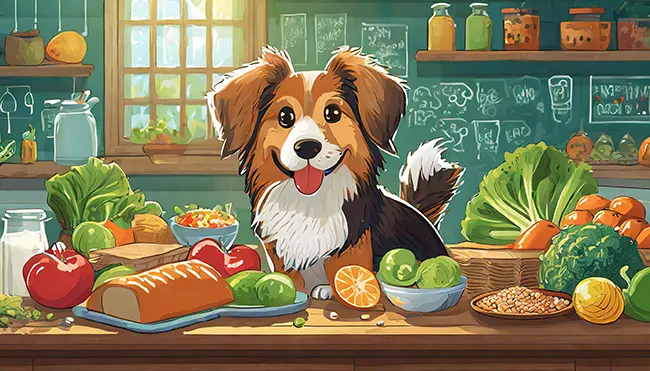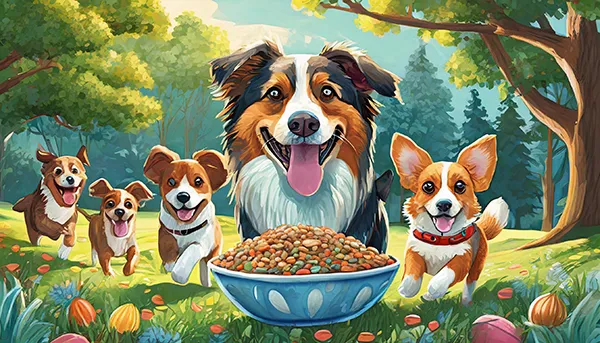
Dogs are more than just pets; they are cherished members of our families who rely on us for their well-being. Dog nutrition is essential to ensuring our canine companions’ bright health and zest for life. Just as humans benefit from good nutrition, a balanced diet tailored to the specific needs of dog nutrition is critical for maintaining their overall health and happiness. By understanding the fundamental aspects of dog nutrition and the importance of well-balanced meals, you can ensure your furry friend leads a long, healthy, and active life.
Basic Nutrition Requirements for Dogs
To thrive, dogs need a diet that is rich in the right balance of proteins, fats, carbohydrates, vitamins, and minerals. Each component plays a vital role in maintaining their overall health.
Proteins: The Building Blocks of Life
Dogs require proteins for the growth, repair, and maintenance of body tissues. They are composed of amino acids, some of which dogs can only get from their diet. Dogs can get high-quality protein from meat, poultry, fish, and, in rare situations, plant-based proteins. These promote muscular growth, tissue repair, and a robust immune system.
Fats: Essential for Energy and Health
Fats provide a concentrated source of energy for dogs, more so than proteins or carbohydrates. They are also necessary for the absorption of fat-soluble vitamins (A, D, E, and K) and for protecting internal organs. Essential fatty acids, such as omega-3 and omega-6, are crucial for maintaining healthy skin and a shiny coat. Sources of good fats include animal fats and oils from seeds.
Carbohydrates: The Energy Provider
Carbohydrates, while less significant than proteins and lipids, are nonetheless vital in a dog’s diet since they provide a source of quickly available energy. They also promote gut health and appropriate digestion. Grain, vegetable, and fruit are all good sources of carbs for dogs. However, it is critical to ensure that nutrients are consumed in proper proportions to avoid weight gain and other health problems.
Vitamins and Minerals: For Metabolic Function
Vitamins and minerals are vital for various metabolic functions. They are crucial for bone health, blood clotting, and preventing disease, among other roles. A well-balanced diet designed for dogs will naturally provide these nutrients. However, some dogs might require supplements, especially if they have specific health needs or are on a homemade diet.
Water: The Essence of Life
Water is, without a doubt, the most critical nutrient. It is essential for all biological processes, including digestion, absorption, circulation, and temperature control. Dogs should constantly have access to fresh, clean water to avoid dehydration and maintain good health.
It is vital to provide your dog with a well-balanced food that meets all of his nutritional needs. Each dog has unique needs based on their breed, age, activity level, and health status, so consult with a veterinarian to properly adjust their diet.
The Importance of a Balanced Diet for Dogs

Understanding the importance of a balanced diet for dogs is essential for their overall health and well-being. A diet that carefully balances all the necessary nutrients—proteins, fats, carbohydrates, vitamins, minerals, and water—not only meets their basic nutritional needs but also enhances their quality of life in several key ways:
Supports Growth and Maintenance
Tailoring your dog’s diet to their specific life stage is crucial. Puppies, for example, require more protein and calories to support rapid growth, while adults need a diet that maintains their health and energy levels. Senior dogs often need fewer calories to prevent obesity but still require high-quality protein and certain nutrients to support joint health and maintain bodily functions. A balanced diet ensures that dogs at every stage of life get the appropriate nutrients for optimal growth and maintenance.
Prevents Obesity
Obesity in dogs is a growing concern and can lead to a myriad of health issues, including diabetes, joint problems, and cardiovascular diseases. Feeding your dog proper portions and ensuring their diet is rich in nutrients but not excessively high in calories can help them manage their weight effectively. A balanced diet includes all the necessary components in the right proportions, avoiding excessive fat and sugar that contribute to weight gain.
Boosts Immune System
A diet that includes a wide range of essential nutrients helps strengthen the immune system. Vitamins, minerals, and antioxidants play a key role in supporting the body’s defenses against infections, diseases, and inflammation. Ensuring your dog’s diet includes these nutrients can help them fight off pathogens and stay healthy.
Enhances Coat and Skin Health
The condition of a dog’s coat and skin is often a reflection of their overall health. Adequate levels of fats and oils, particularly omega-3 and omega-6 fatty acids, are vital for maintaining a shiny coat and healthy skin. These nutrients help reduce inflammation and support the skin’s barrier function, reducing the risk of dermatological issues and infections.
Supports Digestive Health
A well-balanced diet rich in fiber promotes digestive health and stool regularity. Fibers improve digestion and promote a healthy gut microbiome, which is essential for nutritional absorption and gastrointestinal health. Fiber-rich carbohydrates, such as certain grains, vegetables, and fruits, should be consumed in sufficient quantities to support these functions.
To summarize, a balanced diet for dogs is more than just filling their bowls with food; it is about delivering the proper nutrients in the right quantities to support their health, energy, and quality of life. A veterinarian can help you choose the optimal food plan for your dog, taking into account their personal needs, preferences, and any health issues they may have.
Tailoring the Diet to Your Dog’s Needs

Tailoring the diet to meet your dog’s individual needs is a fundamental aspect of responsible pet ownership. Dogs, much like humans, have varied nutritional requirements that can change throughout their lives and be influenced by several factors. Recognizing and adapting to these needs can significantly enhance your dog’s health, happiness, and longevity. Here’s how to approach this:
Factors Influencing Dietary Needs
- Age: Nutritional requirements vary significantly across different life stages. Puppies need diets rich in calories and protein to support their rapid growth, adult dogs require balanced nutrition to maintain their health and energy, and senior dogs may need adjustments to manage weight and support joint health.
- Breed: The breed can influence dietary needs due to the variance in size, energy levels, and predispositions to certain health conditions. For example, larger breeds might need food that supports joint health, while smaller breeds might require diets with smaller kibble sizes.
- Weight: Managing your dog’s weight is crucial for preventing obesity-related health issues. The diet may need to be adjusted in calories and exercise regimes tailored to achieve or maintain an ideal weight.
- Activity Level: Highly active dogs or working dogs require more calories and specific nutrients to support their energy output, while less active dogs need fewer calories to prevent weight gain.
- Health Conditions: Dogs with health issues such as diabetes, kidney disease, or food allergies might require specialized diets formulated to manage these conditions.
Consultation with a Veterinarian
Consultation with a veterinarian is essential when adjusting your dog’s diet. They may evaluate your dog’s overall health, take into account the criteria listed above, and offer a nutrition plan that is tailored to your dog’s individual requirements. This is especially important for dogs with health problems, as an improper diet can aggravate existing disorders.
Consideration of Special Diets
For dogs with allergies, sensitivities, or specific health concerns, specialized diets may be essential. This can include hypoallergenic diets, grain-free options, or foods formulated with limited ingredients to minimize the risk of allergic reactions. Dogs with health conditions such as kidney disease or diabetes may need diets with specific nutrient profiles to manage these issues effectively.
Adjustments and Monitoring
After consulting with a veterinarian and making dietary adjustments, it’s important to monitor your dog’s response to the new diet. Look for changes in weight, energy levels, coat condition, and overall health. Regular check-ups with your vet can help track progress and make further adjustments as needed.
In summary, recognizing and adapting to your dog’s unique dietary needs is a dynamic process that involves careful consideration of various factors and close collaboration with a veterinarian. By doing so, you can ensure your dog receives the optimal nutrition for their specific requirements, supporting their health and happiness throughout their life.
The Importance Of A Balanced Diet For Dogs

A balanced diet is fundamental to a dog’s health, significantly influencing their vitality, longevity, and well-being. Dogs have unique nutritional requirements that differ by breed, life stage, and health status, necessitating a tailored approach to their feeding. Originally descended from wild canines with diets high in proteins and fats, today’s domestic dogs require a carefully balanced intake that supports their diverse lifestyles and specific health needs.
This includes not only the right balance of macronutrients—proteins, fats, and carbohydrates—but also essential vitamins and minerals to prevent disease, support growth, and maintain optimal physical and mental health. Recognizing and meeting these unique dietary needs is essential for maintaining a dog’s health, affecting everything from their skin and coat condition to their immune system and quality of life. Ensuring dogs receive a properly balanced diet is a cornerstone of responsible pet ownership, laying the groundwork for a healthy, happy life together.
Benefits of a Balanced Diet
A balanced diet offers numerous benefits that are critical to the overall health and well-being of dogs. Here’s a deeper look into how a balanced diet impacts their health:
Supports Growth and Maintenance
For dogs, especially in their growing years, a balanced diet is crucial for proper development. Puppies require a diet rich in proteins, fats, and specific vitamins and minerals to support their rapid growth and bone development. As dogs mature into adulthood and eventually into their senior years, their dietary needs shift to maintenance and the prevention of age-related issues. A balanced diet ensures that dogs of all ages receive the necessary nutrients to build and repair tissues, supporting overall bodily functions and health.
Enhances Immune System
Nutrients such as proteins, essential fatty acids, vitamins, and minerals play a significant role in strengthening a dog’s immune system. A diet that includes the right balance of these nutrients can help dogs fend off infections and diseases more effectively. Antioxidants found in certain vitamins (like Vitamins E and C) are particularly important for neutralizing free radicals, reducing oxidative stress, and supporting immune health.
Maintains Healthy Weight
Obesity in dogs can lead to numerous health problems, including diabetes, joint issues, and cardiovascular diseases. Conversely, undernutrition can lead to a weakened immune system and poor bone health. A balanced diet helps maintain an ideal weight, ensuring dogs receive enough energy for daily activities without excess calories that can lead to weight gain. Proper portions and nutrient-dense foods are key to achieving this balance.
Promotes Healthy Skin and Coat
The condition of a dog’s skin and coat is a direct reflection of their diet’s quality. Essential fatty acids, such as omega-3 and omega-6, found in fish oils and certain plant oils, are vital for maintaining healthy skin and a shiny coat. These fats help reduce inflammation and provide the building blocks for healthy skin cells and fur. Vitamins and minerals, including zinc and vitamin A, also play a crucial role in skin health and fur quality.
In summary, a balanced diet is the foundation of a healthy, vibrant life for dogs. It supports their growth, immune system, weight management, and the health of their skin and coat. Ensuring dogs receive a balanced diet tailored to their specific needs is one of the most important responsibilities of pet ownership, directly impacting their quality of life and longevity.
Consequences of Nutritional Imbalance
Nutritional imbalances in dogs can lead to a range of serious health consequences, emphasizing the importance of a well-balanced diet. Here’s how such imbalances can affect a dog’s health:
Obesity and Undernutrition
Obesity is one of the most common nutrition-related issues in dogs and can significantly shorten a dog’s lifespan. Excess weight puts additional stress on a dog’s body, leading to a higher risk of diabetes, joint and bone problems, heart disease, and decreased liver function. It can also exacerbate respiratory difficulties and increase the risk of heatstroke.
Undernutrition, on the other hand, occurs when a dog’s diet does not provide sufficient energy or nutrients. This can lead to weight loss, muscle wasting, and a general decline in health. Puppies suffering from undernutrition may experience stunted growth and development issues, while adult dogs can become more susceptible to infections due to a weakened immune system.
Diseases and Health Issues
Nutritional imbalances can directly contribute to the development of various diseases and health issues beyond just weight-related problems:
- Skin and Coat Problems: An imbalance of essential nutrients like fatty acids, vitamins, and minerals can lead to dull coats, skin allergies, and infections.
- Digestive Disorders: Inadequate or excess levels of certain nutrients can cause gastrointestinal issues, such as diarrhea, vomiting, and constipation.
- Bone and Joint Diseases: An improper balance of calcium and phosphorus can lead to bone and joint problems, particularly in rapidly growing large breed puppies, potentially resulting in conditions like hip dysplasia or osteochondrosis.
- Heart Disease: Certain nutritional imbalances, such as an excess of sodium or a deficiency in taurine and L-carnitine, can contribute to heart disease in dogs.
- Dental Problems: Poor nutrition can also affect oral health, leading to dental diseases like gingivitis and periodontitis, which can cause pain and lead to further systemic health issues.
Considerations for a Balanced Diet
When formulating a balanced diet for dogs, several key considerations must be taken into account to ensure their nutritional needs are met effectively. These considerations include the dog’s life stage, activity level, breed size, and any specific health needs they may have. Tailoring a diet with these factors in mind is crucial for supporting optimal health throughout a dog’s life.
Life Stage (Puppy, Adult, Senior)
Puppies have higher energy needs and require more protein, vitamins, and minerals per pound of body weight than adult dogs to support their rapid growth and development. Their diet must be rich in nutrients essential for bone growth, organ development, and immune system strength.
Adult dogs require a balanced diet that maintains their health, supports their energy levels for daily activities, and prevents obesity. The focus shifts from growth to maintaining a healthy weight and supporting an active lifestyle.
Senior dogs often have lower energy requirements and may need diets lower in calories but still rich in easily digestible proteins to maintain muscle mass. They may also require adjustments in nutrients to address age-related health issues such as joint health or kidney function.
Activity Level
Active dogs and working dogs (such as those involved in herding, hunting, or rescue operations) have higher energy requirements and may need a diet higher in calories and proteins to fuel their activities and recover properly.
Conversely, dogs with a more sedentary lifestyle require fewer calories to avoid weight gain, emphasizing the need for a diet tailored to their lower energy expenditure.
Breed Size and Specific Needs
Breed size plays a significant role in nutritional needs. Large and giant breeds, for example, have different requirements for bone and joint health, often needing diets formulated to support slower growth rates and reduce the risk of skeletal problems.
Specific needs can include dietary sensitivities, allergies, or health conditions that require specialized diets. For instance, some breeds are prone to heart problems and may benefit from diets with specific nutrients to support cardiovascular health. Others may need diets low in certain proteins or fats due to liver or kidney conditions.
Choosing the Right Food

Choosing the right food for your dog is a critical decision that can significantly impact their health and well-being. This choice often boils down to selecting between commercial diets and homemade meals, understanding food labels, and knowing when and how to use supplements. Here’s a breakdown of these important considerations:
Commercial vs. Homemade Diets
Commercial Diets are formulated to meet the nutritional levels established by the AAFCO Dog Food Nutrient Profiles, ensuring that they provide complete and balanced nutrition for specific life stages or lifestyles. These diets come in various forms, including dry kibble, wet food, and semi-moist options, each with its advantages and disadvantages regarding convenience, cost, and nutritional content.
Homemade Diets offer the advantage of control over the ingredients and the freshness of the food. However, creating a nutritionally balanced homemade diet requires thorough knowledge of canine nutrition to avoid deficiencies or excesses of certain nutrients. Consulting with a veterinary nutritionist is crucial when opting for homemade meals to ensure they meet your dog’s dietary needs.
Reading and Understanding Food Labels
Food labels provide essential information about the nutritional value of dog food. Understanding these labels can help you choose the best product for your dog. Key components to look for include:
- Guaranteed Analysis: This section provides information on the minimum percentages of crude protein and fat and the maximum percentages of crude fiber and moisture.
- Ingredient List: Ingredients are listed in descending order by weight. The first few ingredients give you an idea of the quality and source of protein (e.g., chicken, beef, peas).
- Nutritional Adequacy Statement: This statement indicates whether the food is complete and balanced for a specific life stage (puppy, adult, senior) or if it’s intended for supplemental feeding only.
The Role of Supplements
While a well-balanced diet should provide all the necessary nutrients, there are circumstances where supplements may be beneficial or necessary:
- Specific Health Conditions: Dogs with certain health issues may require supplements. For example, omega-3 fatty acids are for joint health, and probiotics are for digestive health.
- Homemade Diets: If you’re feeding a homemade diet, supplements can help ensure that your dog’s nutritional needs are fully met, covering any potential gaps in the diet.
- Life Stage Requirements: Puppies, pregnant or nursing females, and senior dogs may have specific nutritional requirements that can be supplemented if not adequately addressed by their main diet.
However, it’s important to consult with a veterinarian before adding any supplements to your dog’s diet to avoid over-supplementation or interactions with other nutrients. Supplements should be used judiciously and tailored to the individual dog’s needs, considering their overall diet and health status.
Consulting with Veterinarians
Consulting with veterinarians plays a pivotal role in ensuring your dog receives the optimal diet for their health and well-being. This section explores the importance of professional guidance and how it aids in tailoring diets to individual needs.
Importance of Professional Guidance
Veterinarians are equipped with the knowledge and experience to assess specific nutritional requirements based on various factors, including age, breed, health status, and lifestyle. Their expertise is invaluable for several reasons:
- Health Assessment: A veterinarian can conduct a comprehensive health evaluation to identify any underlying conditions that might influence dietary needs. For example, a dog with diabetes may require a diet lower in carbohydrates, while one with kidney disease may need reduced phosphorus intake.
- Nutritional Expertise: Veterinarians have a deep understanding of canine nutrition and can recommend diets that meet all of a dog’s nutritional needs, preventing deficiencies or excesses that can lead to health issues.
- Product Knowledge: They are also familiar with the multitude of commercial diets available and can recommend high-quality foods that best fit your dog’s specific requirements.
Tailoring Diet to Individual Needs
Each dog is unique, and what works for one may not work for another. Tailoring a diet to an individual dog’s needs is essential for their overall health and longevity. Here are key aspects where veterinary input can personalize a diet:
- Life Stage Nutrition: Nutritional needs vary significantly from puppies to seniors. Veterinarians can guide the most appropriate diet for each life stage, ensuring proper growth and aging.
- Activity Level and Weight Management: For active dogs or those prone to weight gain, veterinarians can recommend diets that match their energy output or help manage weight effectively.
- Special Diets for Health Conditions: Dogs with specific health issues such as allergies, gastrointestinal problems, or chronic conditions like heart disease may require specialized diets. Veterinarians can prescribe therapeutic diets that address these health concerns.
- Supplements and Additives: If supplements are necessary, a veterinarian can suggest the appropriate type and dosage to complement the diet without risking nutrient imbalances.
Conclusion
In conclusion, the importance of balanced nutrition in a dog’s life cannot be overstated. A well-crafted diet is the foundation of good health, impacting everything from growth and development to the immune system and longevity. Balanced nutrition supports not only the physical well-being of dogs but also their mental health and quality of life.
Providing your dog with a diet that meets their specific nutritional requirements is a crucial aspect of responsible pet ownership. It requires an understanding of the unique needs of your dog based on their life stage, activity level, breed size, and any special health considerations. This attention to detail in their diet can prevent nutritional imbalances that lead to obesity, undernutrition, and a host of other health issues.
Investing in quality dog nutrition means more than just buying the most expensive food on the shelf; it involves selecting a diet that is complete, balanced, and appropriate for your dog’s individual needs. It’s about reading labels, understanding ingredients, and, when necessary, choosing supplements wisely under the guidance of a veterinarian.
Consulting with veterinarians is paramount to tailoring a diet that supports your dog’s health throughout all stages of life. These professionals provide invaluable advice, helping you navigate the vast array of dietary options and ensure that the diet you choose promotes your dog’s well-being.
Encouraging investment in quality dog nutrition is not just about ensuring your pet has the best possible food; it’s about acknowledging the role of diet in preventing disease, extending lifespan, and enhancing the quality of life for these cherished members of our families. By prioritizing balanced nutrition, we give our dogs the best chance to thrive alongside us, sharing more joyful, healthy years together.



